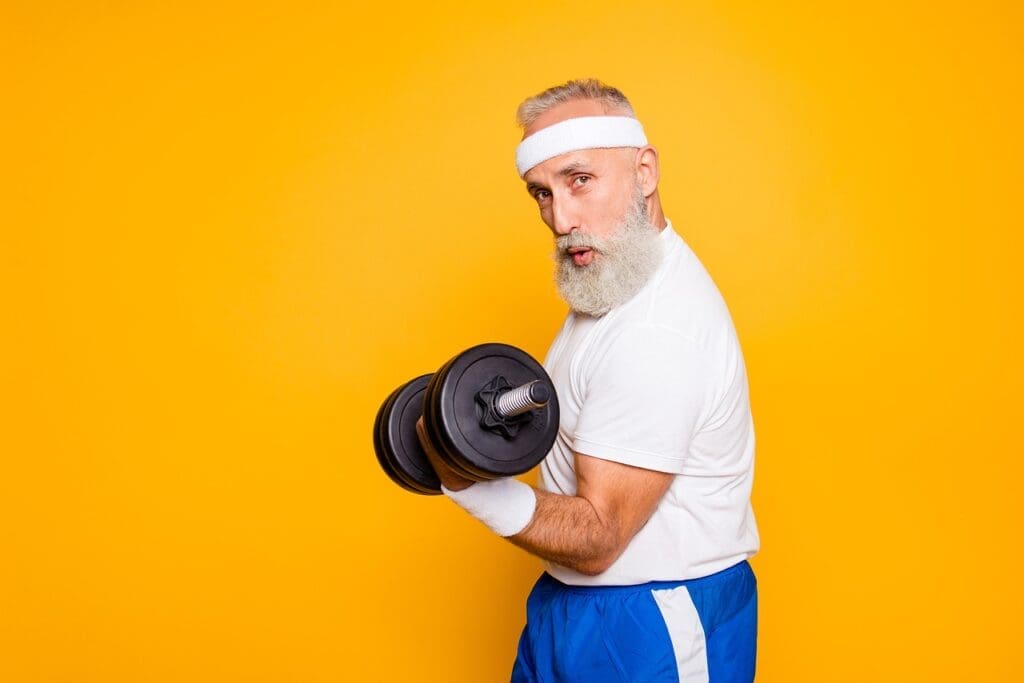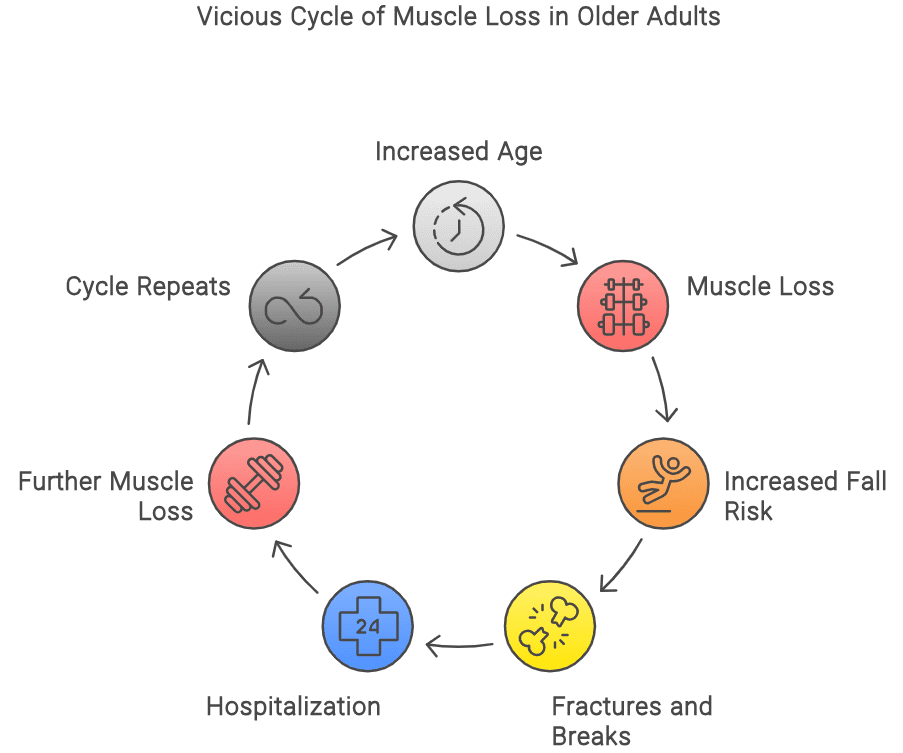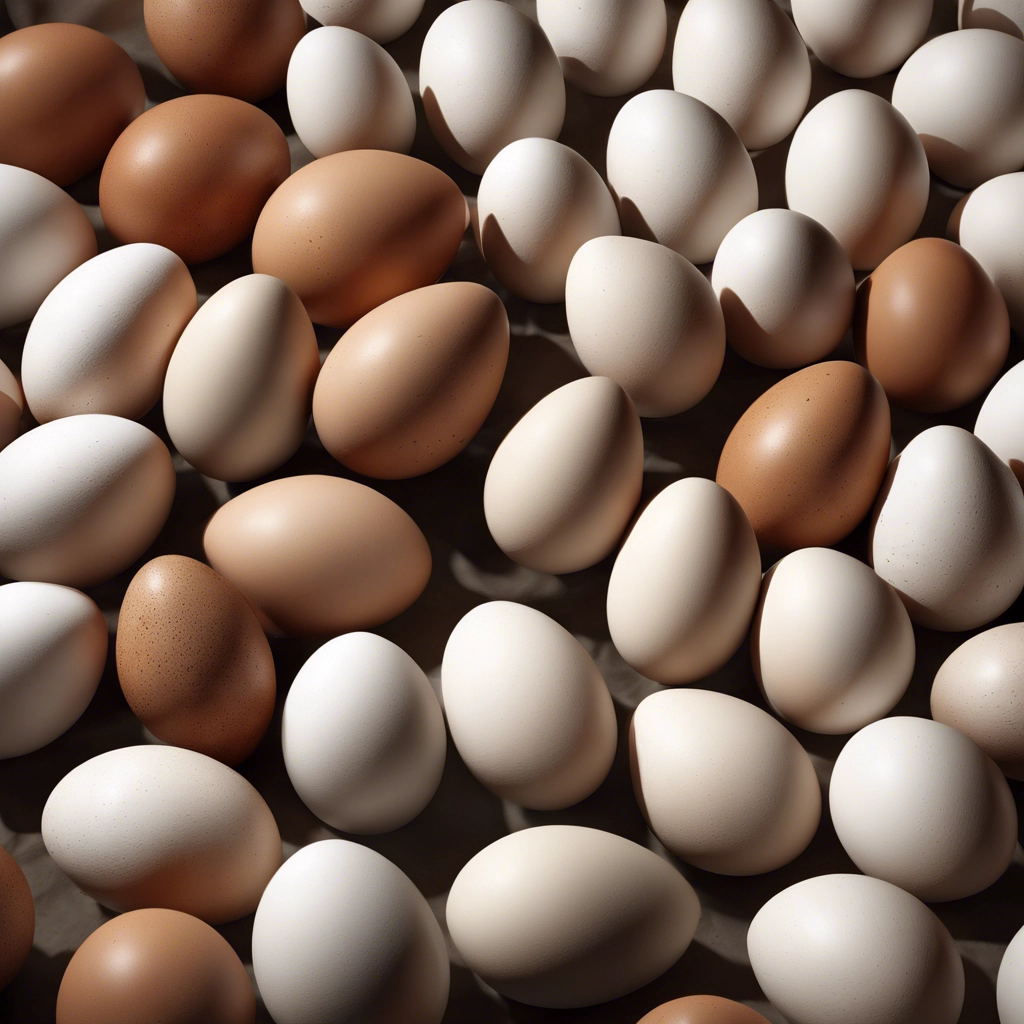
Did you know age related muscle loss actually starts in our 40’s and 50’s? A lot younger than people may think. As we age there is an increased need for protein in our diets, compared to when we are younger. This is necessary to help replace and repair our muscles, and to help prevent muscle loss. With an aging population in Australia, this is becoming an increasingly important issue to help older people maintain their health, independence and functionality.
Protein is not just for ‘building’ muscle, it is also super important in maintaining muscle size and strength, especially as we age, as it becomes even harder to get it back. Unfortunately, it is a lot harder to build muscle when we’re older, so maintaining the muscle we have is even more important!
When we lose muscle, we lose strength which leads to an increased chance of falls – which may lead to fractures and breaks. This can also turn into a cycle: imagine you break a bone in your leg, you go to hospital, they fix you up, but you cannot use that leg for a few weeks, which leads to muscle and strength loss. Your loss of strength and muscle in you legs increases you chance of a fall, in turn increasing the chance of a fracture or break, meaning you have to go to hospital. And the cycle repeats. While in hospital you can lose as much as 1kg of muscle loss in as little as 10 days!
Muscles do more in our bodies than just keep us upright and moving – muscles store energy; they’re a store of protein for use around the body in times of need or illness; muscles have a role in brain health and metabolic health (e.g. preventing diabetes). So I’m sure you’re starting to see the importance of muscles for our overall health.

How much protein do you need?
It depends on a few things: each person’s needs, based on physical activity level, energy use and medical conditions. But we can use a general guide to calculate your protein requirements. I have also added a calculator for an easy reference for you to use below.
0.75g per kg of your body weight is the requirement for a sedentary (sitting at an office all day, for example) person.
So, for a 75kg person, it’s 0.75 X 75 = 56.25g per day.
But depending on how active you are, any medical conditions and, of course, your age, that will increase.
For example, athletes trying to build muscle may need 1.8g per kg of body weight!
That’s 135g per day for our 75kg person we used as an example before.
But a generally active adult that weighs 75kgs may need ~1.0g per kg per day.
That’s 1.0 X 75 = 75g per day.
How much protein do older adults need?
The evidence now suggests 1.0g – 1.2g per kg of body weight.
So, our example of the 75kg person before, would need 75 – 90g a day, if they were sedentary (sitting at an office, for example) most of the day.
But this is not taking into account exercise – so an older adult that is active will need above 1.2g per kg of body weight. But depending on your activity levels, your personal circumstances and needs, this will be different for you. So, if you want to make sure you are getting enough as you are getting older, see an Accredited Practising Dietitian for personalised and tailored advice.
What does 75g of protein look like?
Understanding what 75g of protein looks like can be quite insightful. Here’s a visual and detailed breakdown:

12 Eggs

360g Trimmed Meat

2L Milk
But when broken down to a meal over the day, it looks something like this:
Breakfast: bowl of cereal with 250ml of milk (8g of protein) and a tub of yogurt (10g protein).
Lunch: 60g of ham (12g protein), 2 slices of cheese (8g protein) with salad in whilegrian bread (8.8g protein) sandwiches.
Dinner: 120g of trimmed meat (30g) with veggies.

Balanced Protein Intake
So now we know how much protein you need per day to maintain, or even increase, your muscle mass as you age.
But here’s the other thing, most people, especially in Australia, tend to have a skewed protein intake, concentrating the majority of their protein in one meal, typically dinner. For example, a chicken parma with meat, cheese, and potatoes contains significant protein but is often consumed in one sitting.
Spreading Protein Throughout the Day
To maintain or increase muscle mass as we age, it is crucial to distribute protein intake more evenly across meals. This means incorporating more protein into breakfast and lunch:
Breakfast: Add protein sources like eggs, Greek yogurt, or milk.
Lunch: Include lean meats, cheese, or plant-based proteins like tofu or lentils.
Leucine - The Key To Building Muscle?
Another important factor is something called leucine – one of the amino acids that makes up proteins – which we know is super important to building muscle. Leucine seems to be a main trigger to tell the body to build muscle compared to any of the other amino acids that make up proteins. How do you make sure you get enough leucine? Well, there is a higher amount of leucine in animal products compared to plant proteins, but you can still obtain plenty of leucine form plant foods. For example:
2 ½ cups of skim milk = 2g leucine
2 ½ cups of soy milk = 1.3g leucine
120g meat = 2g leucine
200g tofu = 1g leucine
200g lentil (~ ½ tin) = 1g leucine
HMB
Leucine also allows our body to make something called HMB (beta-hydroxy- beta-methylbutyrate), let’s just call it HMB for now. HBM seems to especially important in preventing muscle loss as we age, which makes it a promising molecule to help maintain muscle. So, you might be asking “Will, you’re telling me about this miraculous thing called HMB, how do I get enough?”. That’s the tough bit, if you want to get it from food, you would need to eat 110 eggs a day! Or how about 6,000 avocados? Or 3.5kgs of black beans?
So, to get enough HMB people need to supplement. But that’s the funny thing about nutrition: no single nutrient can ensure overall health and muscle growth. Optimal well-being comes from a balanced diet that provides a range of nutrients. Prioritising a varied and comprehensive diet is essential, rather than focusing solely on protein, leucine, or HMB.
Other Essential Amino Acids
While leucine is crucial, other essential amino acids play significant roles in protein synthesis and overall health:
- Isoleucine: Found in meats, fish, eggs, cheese, and soy.
- Valine: Found in grains, dairy products, meats, and soy.
- Lysine: Found in meats, fish, dairy, and some plants like quinoa and lentils.
Ensuring a balanced intake of all essential amino acids through a varied diet helps support muscle growth, repair, and overall well-being.
Exercise
Finally, it’s also really important to maintain a good level of physical activity as you get older – this is to make sure the protein that you eat actually eat is used to help you build muscle and maintain strength. The best exercise for maintaining muscle and improving strength is resistance training – lifting weights – 2-3 days a week. If you want to get super specific, doing ‘power’ movements is even better! That means performing lighter weight exercises, but quickly. But talk to your doctor for advice, or an exercise physiologist to get a program for your specific needs. But remember, any and all exercise is helpful for maintaining muscle!
Key Guidelines for Effective Muscle Maintenance and Building

The research is always finding new ways to help us maintain and build muscle, and the internet can be misleading and confusing at the best of times. But there are a few simple rules based on what we have talked about above:
1 – Eat enough protein.
This is based on your individual needs, and as long as you have a well-rounded diet, the type of protein will not be as important as getting enough.
2 – Spread your protein out over the day.
Try to have protein at each meal for maximum benefit in muscle repair and building.
3 – Maintain physical activity.
Any exercise helps maintain and build muscle, even as we get older. If you need help, and exercise physiologist or personal trainer can help guide you in the right direction.
Following these 3 main rules, and seeking advice from professionals (Accredited Practising Dietitians) when you need some help, will give you the tools you need to keep yourself strong, active and healthy as you get older. Because the reality is, we are all getting older, and we will all see the effects of ageing on our bodies The best thing we can do is try to maintain our muscle and health for as long as possible!